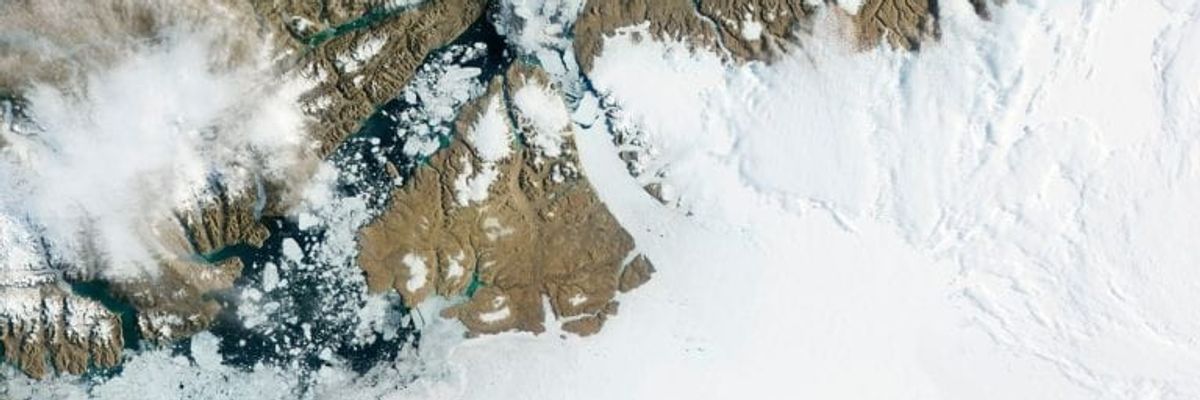
In the center of this NASA photograph taken in 2012, Petermann Glacier in northwest Greenland gradually moves toward the ocean, with large segments breaking off and drifting away as icebergs. Researchers at UCI and NASA JPL used satellite data from three European missions to learn how warm ocean water is causing the migration of the glacier’s grounding line, leading to its rapid deterioration.
'Bad News': Unexpected Melting of Greenland Glacier Could Double Sea-Level Rise Projections
The way that the Petermann Glacier in Northwest Greenland is melting indicates that current models are too conservative.
A glacier in the north of Greenland is melting faster and in a different way than scientists previously thought, and this has troubling implications for the future speed of global sea-level rise.
The new discovery was published in the Proceedings of the National Academy of Sciences Monday. The scientists found that warming ocean water had melted a cavity in the bottom of Petermann Glacier taller than the Washington Monument, as The Associated Press reported. If other glaciers in Greenland and Antarctica behave the same way, it could double predictions for how quickly the burning of fossil fuels will melt ice and raise sea levels.
"It's bad news," study author Eric Rignot, a University of California, Irvine (UCI), glaciologist, told the AP. "We know the current projections are too conservative."
"This is an order of magnitude larger than expected for grounding lines on a rigid bed."
The Petermann Glacier is a massive glacier in Northwest Greenland that contains enough ice to raise sea levels by a little more than a foot, the study authors noted. It is one of four Greenland ice masses that make up "the largest threat for rapid sea-level rise from Greenland in the coming decades" since they drain into the ocean below sea level.
Up until recently, however, the glacier was relatively stable, gaining about as much mass each year as it lost. That began to change in 2016, when the center of its grounding line began to edge backward at a rate of 0.6 miles per year.
A glacier's grounding line is the place where it moves from being supported by land to floating on the ocean, and it's this feature of Petermann that is the focus of the new study. The scientists from UCI, NASA's Jet Propulsion Laboratory at the California Institute of Technology, the University of Houston, Finland's Iceye mission, China's Tongji University, the German Aerospace Center, and the Italian Space Agency used satellite radar data to learn that the grounding line was moving significantly with the tides.
"Petermann's grounding line could be more accurately described as a grounding zone, because it migrates between 2 and 6 kilometers [approximately 1.2 to 3.7 miles] as tides come in and out," lead author Enrico Ciraci, a UCI assistant specialist in Earth system science and NASA postdoctoral fellow, said in a statement. "This is an order of magnitude larger than expected for grounding lines on a rigid bed."
This movement, in turn, accelerated ice melt.
"These ice-ocean interactions make the glaciers more sensitive to ocean warming," Rignot explained.
Between 2016 and 2022, the grounding line retreated by more than two miles. During that time, the warmer ocean water melted a 669-foot tall cavity at the bottom of the glacier. The melt rates around the cavity for 2020-21 were 50% greater than the melt rates for 2016-19, and, during 2022, the cavity stayed open the entire year.
What's especially concerning to the study authors is that what happens in Petermann may not stay in Petermann.
"These dynamics are not included in models," Rignot said.
If they were included, it could double sea-level rise projections, the study authors observed.
Hélène Seroussi, a glaciologist at Dartmouth College who was not involved with the study, cautioned The Washington Post that models for ice melt and sea-level rise would not incorporate these findings overnight, since scientists still need to determine how many glaciers they really apply to. However, Seroussi acknowledged that the measurements were unprecedented.
"The melt rates reported are very large, much larger than anything we suspected in this region," Seroussi said.
Andreas Muenchow of the University of Delaware, a scientist who studies Petermann Glacier but was also not a part of the study, further told the Post that the high melt rates were observed over a relatively small area.
"My main takeaway is that models need to be improved," Muenchow said.
An Urgent Message From Our Co-Founder
Dear Common Dreams reader, The U.S. is on a fast track to authoritarianism like nothing I've ever seen. Meanwhile, corporate news outlets are utterly capitulating to Trump, twisting their coverage to avoid drawing his ire while lining up to stuff cash in his pockets. That's why I believe that Common Dreams is doing the best and most consequential reporting that we've ever done. Our small but mighty team is a progressive reporting powerhouse, covering the news every day that the corporate media never will. Our mission has always been simple: To inform. To inspire. And to ignite change for the common good. Now here's the key piece that I want all our readers to understand: None of this would be possible without your financial support. That's not just some fundraising cliche. It's the absolute and literal truth. We don't accept corporate advertising and never will. We don't have a paywall because we don't think people should be blocked from critical news based on their ability to pay. Everything we do is funded by the donations of readers like you. Will you donate now to help power the nonprofit, independent reporting of Common Dreams? Thank you for being a vital member of our community. Together, we can keep independent journalism alive when it’s needed most. - Craig Brown, Co-founder |
A glacier in the north of Greenland is melting faster and in a different way than scientists previously thought, and this has troubling implications for the future speed of global sea-level rise.
The new discovery was published in the Proceedings of the National Academy of Sciences Monday. The scientists found that warming ocean water had melted a cavity in the bottom of Petermann Glacier taller than the Washington Monument, as The Associated Press reported. If other glaciers in Greenland and Antarctica behave the same way, it could double predictions for how quickly the burning of fossil fuels will melt ice and raise sea levels.
"It's bad news," study author Eric Rignot, a University of California, Irvine (UCI), glaciologist, told the AP. "We know the current projections are too conservative."
"This is an order of magnitude larger than expected for grounding lines on a rigid bed."
The Petermann Glacier is a massive glacier in Northwest Greenland that contains enough ice to raise sea levels by a little more than a foot, the study authors noted. It is one of four Greenland ice masses that make up "the largest threat for rapid sea-level rise from Greenland in the coming decades" since they drain into the ocean below sea level.
Up until recently, however, the glacier was relatively stable, gaining about as much mass each year as it lost. That began to change in 2016, when the center of its grounding line began to edge backward at a rate of 0.6 miles per year.
A glacier's grounding line is the place where it moves from being supported by land to floating on the ocean, and it's this feature of Petermann that is the focus of the new study. The scientists from UCI, NASA's Jet Propulsion Laboratory at the California Institute of Technology, the University of Houston, Finland's Iceye mission, China's Tongji University, the German Aerospace Center, and the Italian Space Agency used satellite radar data to learn that the grounding line was moving significantly with the tides.
"Petermann's grounding line could be more accurately described as a grounding zone, because it migrates between 2 and 6 kilometers [approximately 1.2 to 3.7 miles] as tides come in and out," lead author Enrico Ciraci, a UCI assistant specialist in Earth system science and NASA postdoctoral fellow, said in a statement. "This is an order of magnitude larger than expected for grounding lines on a rigid bed."
This movement, in turn, accelerated ice melt.
"These ice-ocean interactions make the glaciers more sensitive to ocean warming," Rignot explained.
Between 2016 and 2022, the grounding line retreated by more than two miles. During that time, the warmer ocean water melted a 669-foot tall cavity at the bottom of the glacier. The melt rates around the cavity for 2020-21 were 50% greater than the melt rates for 2016-19, and, during 2022, the cavity stayed open the entire year.
What's especially concerning to the study authors is that what happens in Petermann may not stay in Petermann.
"These dynamics are not included in models," Rignot said.
If they were included, it could double sea-level rise projections, the study authors observed.
Hélène Seroussi, a glaciologist at Dartmouth College who was not involved with the study, cautioned The Washington Post that models for ice melt and sea-level rise would not incorporate these findings overnight, since scientists still need to determine how many glaciers they really apply to. However, Seroussi acknowledged that the measurements were unprecedented.
"The melt rates reported are very large, much larger than anything we suspected in this region," Seroussi said.
Andreas Muenchow of the University of Delaware, a scientist who studies Petermann Glacier but was also not a part of the study, further told the Post that the high melt rates were observed over a relatively small area.
"My main takeaway is that models need to be improved," Muenchow said.
- UN Chief Demands Action as Sea Level Rise Threatens Exodus of 'Biblical Scale' ›
- Melting of Greenland Ice Sheet Poised to Trigger Almost a Foot of Sea-Level Rise: Study ›
- 'Frightening': Greenland Losing 33 Million Tons of Ice Per Hour Due to Climate Crisis ›
- Researchers Warn of Imminent 'Death Spiral' for Rapidly Melting Alaska Ice Field | Common Dreams ›
- Rising Seas From Fossil Fuels Threaten Inland Migration 'Never Witnessed in Modern Civilization' | Common Dreams ›
A glacier in the north of Greenland is melting faster and in a different way than scientists previously thought, and this has troubling implications for the future speed of global sea-level rise.
The new discovery was published in the Proceedings of the National Academy of Sciences Monday. The scientists found that warming ocean water had melted a cavity in the bottom of Petermann Glacier taller than the Washington Monument, as The Associated Press reported. If other glaciers in Greenland and Antarctica behave the same way, it could double predictions for how quickly the burning of fossil fuels will melt ice and raise sea levels.
"It's bad news," study author Eric Rignot, a University of California, Irvine (UCI), glaciologist, told the AP. "We know the current projections are too conservative."
"This is an order of magnitude larger than expected for grounding lines on a rigid bed."
The Petermann Glacier is a massive glacier in Northwest Greenland that contains enough ice to raise sea levels by a little more than a foot, the study authors noted. It is one of four Greenland ice masses that make up "the largest threat for rapid sea-level rise from Greenland in the coming decades" since they drain into the ocean below sea level.
Up until recently, however, the glacier was relatively stable, gaining about as much mass each year as it lost. That began to change in 2016, when the center of its grounding line began to edge backward at a rate of 0.6 miles per year.
A glacier's grounding line is the place where it moves from being supported by land to floating on the ocean, and it's this feature of Petermann that is the focus of the new study. The scientists from UCI, NASA's Jet Propulsion Laboratory at the California Institute of Technology, the University of Houston, Finland's Iceye mission, China's Tongji University, the German Aerospace Center, and the Italian Space Agency used satellite radar data to learn that the grounding line was moving significantly with the tides.
"Petermann's grounding line could be more accurately described as a grounding zone, because it migrates between 2 and 6 kilometers [approximately 1.2 to 3.7 miles] as tides come in and out," lead author Enrico Ciraci, a UCI assistant specialist in Earth system science and NASA postdoctoral fellow, said in a statement. "This is an order of magnitude larger than expected for grounding lines on a rigid bed."
This movement, in turn, accelerated ice melt.
"These ice-ocean interactions make the glaciers more sensitive to ocean warming," Rignot explained.
Between 2016 and 2022, the grounding line retreated by more than two miles. During that time, the warmer ocean water melted a 669-foot tall cavity at the bottom of the glacier. The melt rates around the cavity for 2020-21 were 50% greater than the melt rates for 2016-19, and, during 2022, the cavity stayed open the entire year.
What's especially concerning to the study authors is that what happens in Petermann may not stay in Petermann.
"These dynamics are not included in models," Rignot said.
If they were included, it could double sea-level rise projections, the study authors observed.
Hélène Seroussi, a glaciologist at Dartmouth College who was not involved with the study, cautioned The Washington Post that models for ice melt and sea-level rise would not incorporate these findings overnight, since scientists still need to determine how many glaciers they really apply to. However, Seroussi acknowledged that the measurements were unprecedented.
"The melt rates reported are very large, much larger than anything we suspected in this region," Seroussi said.
Andreas Muenchow of the University of Delaware, a scientist who studies Petermann Glacier but was also not a part of the study, further told the Post that the high melt rates were observed over a relatively small area.
"My main takeaway is that models need to be improved," Muenchow said.
- UN Chief Demands Action as Sea Level Rise Threatens Exodus of 'Biblical Scale' ›
- Melting of Greenland Ice Sheet Poised to Trigger Almost a Foot of Sea-Level Rise: Study ›
- 'Frightening': Greenland Losing 33 Million Tons of Ice Per Hour Due to Climate Crisis ›
- Researchers Warn of Imminent 'Death Spiral' for Rapidly Melting Alaska Ice Field | Common Dreams ›
- Rising Seas From Fossil Fuels Threaten Inland Migration 'Never Witnessed in Modern Civilization' | Common Dreams ›

